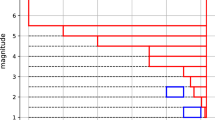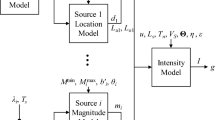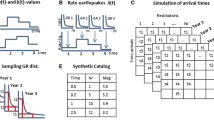Abstract
This work proposes a new approach, based on Bayesian updating and extreme value statistics to determine the maximum magnitudes for truncated magnitude-frequency distributions such as the Gutenberg Richter model in the framework of Probabilistic Seismic Hazard Analyses. Only the maximum observed magnitude and the associated completeness period are required so that the approach is easy to implement and there is no need to determine and use the completeness periods for smaller events. The choice of maximum magnitudes can have a major impact on hazard curves when long return periods as required for safety analysis of nuclear power plants are considered. Here, not only a singular value but a probability distribution accounting for prior information, data and uncertainty is provided. Moreover, uncertainties related to magnitude frequency distributions, including the uncertainty related to the maximum observed magnitude are discussed and accounted for. The accuracy of the approach is validated based on simulated catalogues with various parameter values. Then the approach is applied to French data for a specific region characterized by high-seismic activity in order to determine the maximum magnitude distribution and to compare the results to other approaches.











Similar content being viewed by others
References
Akkar, S., Sandıkkaya, M. A., Şenyurt, M., Azari, S. A., Ay, B. Ö., Traversa, P., et al. (2014). Reference database for seismic ground-motion in Europe (RESORCE). Bulletin of Earthquake Engineering. https://doi.org/10.1007/s10518-013-9506-8
Ameri, G. (2014) Integration of sigma improvement for PSHA and sensibility studies (intermediate results). Report SIGMA-2014-D4–138, Sections 4 5 and Annexe 4.
Ameri, G., Baumont, D., Gomes, C., Dortz, Le., Goff, Le., & Martin, S. (2015). On the choice of maximum earthquake magnitude for seismic hazard assessment in metropolitan France—insight from the Bayesian approach. Paris: Colloque AFPS.
Anderson, J. G. (1979). Estimating the seismicity from geological structure for seismic risk studies. Bulletin of the Seismological Society of America, 69, 135–158.
Beirlant, J., Goegebeur, Y., Segers, J., & Teugels, J. (2004). Statistics of extremes: theory and applications. Probability and statistics. Hoboken: Wiley.
Bommer, J. J., & Crowley, H. (2017). The purpose and definition of the minimum magnitude limit in PSHA calculations. Seismological Research Letters, 88(4), 1097–1106.
Bommer, J. J., Coppersmith, K. J., Coppersmith, R. T., et al. (2015). A SSHAC level 3 probabilistic seismic hazard analysis for a new-build nuclear site in South Africa. Earthquake Spectra, 31(2), 661–698. https://doi.org/10.1193/060913EQS145M
Burton, M. (1985). Seismic risk of circum-pacific earthquakes: II. Extreme values using Gumbel’s third distribution and the relationship with strain energy release. Pure and Applied Geophysics, 123(6), 849–869. ((Birkhäuser Verlag, Basel)).
Campbell, K. W. (1982). Bayesian analysis of extreme earthquake occurrences. Part I. Probabilistic hazard model. Bulletin of the Seismological Society of America, 72(5), 1689–1705.
Campbell, K. W. (1983). Bayesian analysis of extreme earthquake occurrences. Part II. Application to the San Jacinto fault zone of Southern California. Bulletin of the Seismological Society of America, 73(4), 1099–1115.
Coles, S. (2001). An introduction to statistical modeling of extreme values. Berlin: Springer-Verlag. ((ISBN 1-85233-459-2)).
Cornell, C. A. (1968). Engineering seismic risk analysis. Bulletin of the Seismological Society of America, 58(5), 1583–1606.
Cornell, C.A. (1994). Statistical analysis of maximum magnitudes. In: The Earthquakes of Stable Continental Regions, Vol. 1. Assessment of Large Earthquake Potential, Electric Power Research Institute, Palo Alto, 5.1–5.27.
Drouet, S., Ameri, G., Le Dortz, K., et al. (2020). A probabilistic seismic hazard map for the metropolitan France. Bulletin of Earthquake Engineering, 18, 1865–1898. https://doi.org/10.1007/s10518-020-00790-7EDF(2017).HID-ProbabilisticseismichazardmapsfortheFrenchmetropolitanterritory.ReportGTR/EDF/0217-1573_rev1
Epstein, B., & Lomnitz, C. (1966). A model for the occurrence of large earthquakes. Nature, 211, 954–956.
Grünthal, G., Stromeyer, D., Bosse, C., Cotton, F., & Bindi, D. (2018). The probabilistic seismic hazard assessment of Germany–-version 2016, considering the range of epistemic uncertainties and aleatory variability. Bulletin of Earthquake Engineering, 16, 4339–4395.
Gutenberg, B., & Richter, C. F. (1944). Frequency of earthquakes in California. Bulletin of the Seismological Society of America, 34(4), 185–188.
Holschneider, M., Zöller, G., & Hainzl, S. (2011). Estimation of the maximum possible magnitude in the framework of a doubly truncated Gutenberg-Richter model. Bulletin of the Seismological Society of America, 101(4), 1649–1659.
Holschneider, M., Zöller, G., Clements, R., & Schorlemmer, D. (2014). Can we test for the maximum possible earthquake magnitude? Journal of Geophysical Research: Solid Earth, 119, 2019–2028. https://doi.org/10.1002/2013JB010319
Jaynes, E. T. (2007). Probability theory: the logic of science (5 print. ed.). Cambridge: Cambridge Univ Press. ((978-0-521-59271-0)).
Johnston. (1994). The stable continental region earthquake database. In: The Earthquakes of Stable Continental Regions, Vol. 1. Assessment of Large Earthquake Potential, Electric Power Research Institute, Palo Alto, 3.1–3. 75.
Kagan, Y. Y., & Jackson, D. D. (2000). Probabilistic forecasting of earthquakes. Geophysical Journal International, 143, 438–453.
Kijko, A. (2004). Estimation of the maximum earthquake magnitude, mmax. Pure and Applied Geophysic. https://doi.org/10.1007/s00024-004-2531-4
Kijko, A., & Singh, M. (2011). Statistical tools for maximum possible earthquake magnitude estimation. Acta Geophysica, 59, 674.
Kijko. (2012). On Bayesian procedure for maximum earthquake magnitude estimation. Research in Geophysics 2 (1).
Knopoff, L., & Kagan, Y. (1977). Analysis of the theory of extremes as applied to earthquake problems. Journal of Geophysical Research, 82(36), 5647–5657.
Koravos, G., Main, I. G., Tsapanos, T. M., & Musson, R. W. (2003). Maximum earthquake magnitudes in the Aegean area constrained by tectonic moment release. Geophysical Journal International, 152, 94–112.
Lomnitz-Adler, L. (1979). A modified form of the Gutenberg-Richter magnitude-frequency relation. Bulletin of the Seismological Society of America, 96(4), 1209–1214.
Main, I. G., & Burton, P. W. (1984). Information theory and the earthquake frequency-magnitude distribution. Bulletin of the Seismological Society of America, 74, 1409–1426.
Manchuel, K., Traversa, P., Baumont, D., Cara, M., Nayman, E., & Durouchoux, C. (2017). The French seismic CATalogue (FCAT-17). Bulletin of the Seismological Society of America. https://doi.org/10.1007/s10518-017-0236-1
Martin, C., Ameri, G., Baumont, D., Carbon, D., Senfaute, G., Thiry, J. M., et al. (2017). Probabilistic seismic hazard assessment for South-Eastern France. Bulletin of Earthquake Engineering, 16(6), 2477–2511. https://doi.org/10.1007/s10518-017-0249-9
Nordquist, J. N. (1945). Theory of largest value applied to earthquake magnitudes. Transactions American Geophysical Union, 26(29), 29–31.
Ordaz, M., & Faccioli, E. (2018). Modelling correlation between Gutenberg-Richter parameters a and b in PSHA. Bulletin of Earthquake Engineering, 16, 1829–1846. https://doi.org/10.1007/s10518-017-0274-8
Pisarenko, V. F., & Sornette, D. (2003). Characterization of frequency of extreme earthquake events by the generalized Pareto distribution. Pure and Applied Geophysics, 160, 2343–2364.
Pisarenko, V. F., Lyubushin, A. A., Lysenko, V. B., & Golubeva, T. B. (1996). Statistical estimation of seismic hazard parameters: Maximum possible magnitude and related parameters. Bulletin of the Seismological Society of America, 86(3), 691–700.
Pisarenko, V. F., Sornette, A., Sornette, D., & Rodkin, M. V. (2008). New approach to the characterization of mmax and the tail of the distribution of earthquake magnitudes. Theory. Pure and Applied Geophysics, 165, 847–888.
Pisarenko, V. F., Sornette, A., Sornette, D., & Rodkin, M. V. (2014). Characterization of the tail of the distribution of earthquake magnitudes by combining the GEV and GPD descriptions of extreme value theory. Pure and Applied Geophysics, 171, 1599–1624.
Raschke, M. (2012). Inference for the truncated exponential distribution. Stochastic Environmental Research and Risk Assessment, 26(1), 127–138.
Raschke, M. (2016). Comment on Pisarenko et al. “Characterization of the tail of the distribution of earthquake magnitudes by combining the GEV and GPD descriptions of extreme value theory.” Pure and Applied Geophysics, 173(2), 701–707.
Rong Y., Bird P., Jackson D.D. (2017). Earthquake potential and magnitude limits in Southern Europe. Proceedings of WCEE, Santiago, Chile.
Salamat, M., Zöller, G., & Amini, M. (2019). Prediction of the maximum expected earthquake magnitude in Iran: From a Catalog with varying magnitude of completeness and uncertain magnitudes. Pure and Applied Geophysics, 176, 3425–3438. https://doi.org/10.1007/s00024-019-02141-3
Stevens, V. L., & Avouac, J.-P. (2017). Determination of mmax from background seismicity and moment conservation. Bulletin of the Seismological Society of America, 107(6), 2578–2596.
Stucchi, et al. (2012). The SHARE European earthquake catalogue (SHEEC) 1000–1899. Journal of Seismology. https://doi.org/10.1007/s10950-012-9335-2
USNRC (2012). Central and eastern united states seismic source characterization for nuclear facilities. Technical Report. EPRI, Palo Alto, CA, U.S. DOE, and U.S. NRC.
Vanneste, K., Vleminckx, B., Stein, S., & Camelbeeck, T. (2016). Could mmax be the same for all stable continental regions? Seismological Research Letters, 87(5), 1214–1223.
Wheeler, R. L. (2016). Maximum magnitude (mmax) in the central and eastern United States for the 2014 U.S. geological survey Hazard Model. Bulletin of the Seismological Society of America, 106(5), 2154–2167. https://doi.org/10.1785/0120160048
Wheeler (2009). Methods for mmax estimation east of the Rocky Mountains. USGS report prepared for US Geological Survey Open-File Report 2009–1018.
Wiemer, S., Danciu, L., Edwards, B., Marti, M., Fäh, D., Hiemer, S., Wössner, J., Cauzzi, C., Kästli, P., Kremer, K. (2016). Seismic hazard model 2015 for Switzerland (SUIhaz2015). Swiss Seismological Service (SED) at ETH Zurich, DOI 10.12686/a2.
Woessner, et al. (2015). The 2013 European Seismic hazard model: Key components and results. Bull EarthqEng, 13(12), 3553–3596.
Zöller, H. (2016). The earthquake history in a fault zone tells us almost nothing about mmax. Seismological Research Letters, 87(1), 132–137.
Zöller, G., & Hainzl, S. (2007). Recurrence time distributions of large earthquakes in a stochastic model for coupled fault systems: The role of fault interaction. Bulletin of the Seismological Society of America, 97(5), 1679–1687.
Zöller, G., Holschneider, M., & Hainzl, S. (2013). The maximum earthquake magnitude in a time horizon: Theory and case studies. Bulletin of the Seismological Society of America, 103(2A), 860–875.
Acknowledgements
This work has been funded by SIGMA-2 project. The authors want to thank Ian Main and the second anonymous reviewer for their careful revisions and detailed feedback that helped us to improve the quality of the paper.
Author information
Authors and Affiliations
Corresponding author
Additional information
Publisher's Note
Springer Nature remains neutral with regard to jurisdictional claims in published maps and institutional affiliations.
Rights and permissions
About this article
Cite this article
Zentner, I., Ameri, G. & Viallet, E. Bayesian Estimation of the Maximum Magnitude mmax Based on the Extreme Value Distribution for Probabilistic Seismic Hazard Analyses. Pure Appl. Geophys. 177, 5643–5660 (2020). https://doi.org/10.1007/s00024-020-02612-y
Received:
Revised:
Accepted:
Published:
Issue Date:
DOI: https://doi.org/10.1007/s00024-020-02612-y




